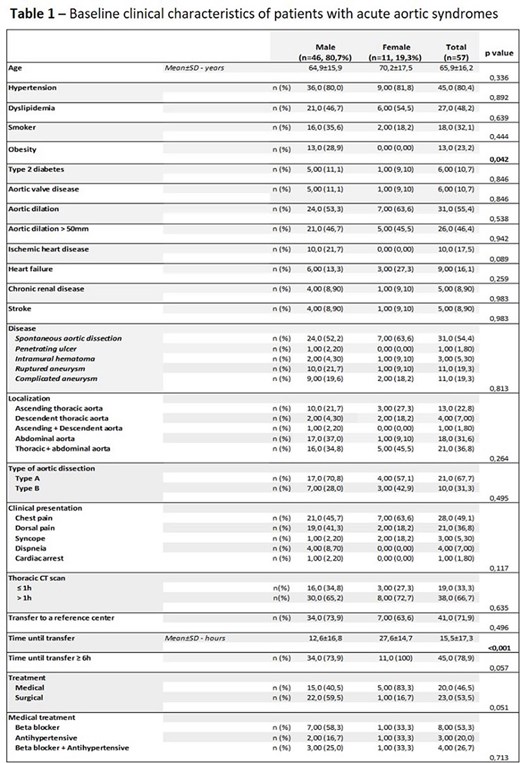-
PDF
- Split View
-
Views
-
Cite
Cite
J Simoes De Azevedo Massa Pereira, S Andraz, L Hamann, H Alex Costa, M Espirito Santo, D Carvalho, P Azevedo, R Fernandes, D Bento, J Sousa Bispo, J Mimoso, Acute aortic syndromes in a center without on-site cardiac surgery, European Heart Journal. Acute Cardiovascular Care, Volume 14, Issue Supplement_1, April 2025, zuaf044.211, https://doi.org/10.1093/ehjacc/zuaf044.211
Close - Share Icon Share
Abstract
Acute aortic syndromes (AAS) are often the first form of presentation of aorta artery diseases, especially classic acute aortic dissection (AAD), with a high mortality rate. Distance to a surgical center and consequently treatment time delay may influence the prognosis of this syndrome.
Characterize the population that suffered an AAS at a hospital without on-site cardiac surgery and without an established emergent pathway in AAS. Analyze global mortality and gender differences in in-hospital mortality (primary outcome) and cardiovascular mortality at 1 year. Try to identify independent predictors of in-hospital mortality in AAS patients.
Retrospective study between 2017/2020, composed of n=57 patients who suffered AAS. Categorical variables are presented as frequencies and percentages, and continuous variables as means and standard deviations, or medians and interquartile ranges for variables with skewed distribution or a significant Shapiro-Wilk test. Multivariate analysis was performed using logistic regression. P value < 0.05 indicates statistical significance.
A total of 57 patients were identified, with a mean age of 65.9 ± 16.2 years, 80.7% were male. 80.4% had hypertension, 48.2% dyslipidemia, 23.2% obesity, 32.1% were smoker and 55.4% had history of aortic dilation. Spontaneous aortic dissection (54.4%) affecting thoracic and abdominal aorta (36.8%) was the more common presentation. The majority of patients were transferred to a reference center (71.9%) with a mean time delay of 15.5±17.3h. Time until transfer ≥ 6h occurred in 78.9% of patients. In-hospital mortality occurred in 42.1%, and 45.6% died after 1 year, without differences between gender. Independent predictors of mortality were time until transfer ≥ 6h (p=0.048, OR 11.1, 95% CI 1.03 to 120), without transfer to a reference center (p=0.005, OR 86.7, 95% CI 3.82 to 1969) and smoking status (p=0.043, OR 5.02, 95% CI 1.05 to 24.1).

Baseline clinical characteristics
Author notes
Funding Acknowledgements: None.
- aorta
- dissection of aorta
- dyslipidemias
- obesity
- smoking
- hypertension
- cardiac surgery procedures
- dilatation of aorta
- arterial disease
- abdominal aorta
- hospital mortality
- surgical procedures, operative
- mortality
- gender
- cardiovascular death
- interval data
- categorical variables
- gender differences
- transfer technique
- acute aortic syndrome
- primary outcome measure
- smokers




Comments